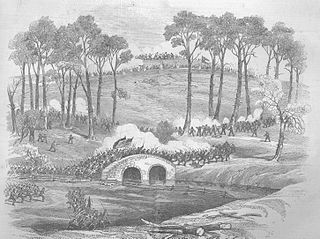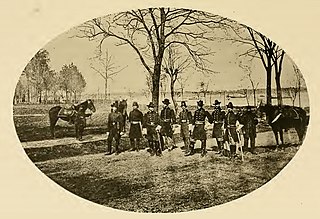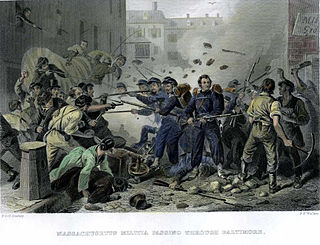
The 28th Massachusetts Infantry regiment was the second primarily Irish American volunteer infantry regiment recruited in Massachusetts for service in the American Civil War. The regiment's motto was Faugh a Ballagh

John Milton Deane was an American Civil War Medal of Honor recipient and a major in the United States Army.
Burnside's North Carolina Expedition was a series of engagements fought along the North Carolina Coast between February and June 1862. The expedition was part of Winfield Scott's overall Anaconda Plan, which aimed at closing blockade-running ports inside the Outer Banks. The amphibious operation was carried out primarily by New England and North Carolina troops under Brig. Gen. Ambrose E. Burnside and assisted by the North Atlantic Blockading Squadron under Captain Louis M. Goldsborough.

The 51st Regiment Massachusetts Volunteer Infantry was a regiment of infantry that served in the Union Army during the American Civil War. The regiment was assigned to Major General John G. Foster's Department of North Carolina, later designated as the XVIII Corps. While based in New Bern, North Carolina, the 51st Massachusetts took part in several expeditions involving numerous units from Foster's command and were engaged in the Battle of Kinston, the Battle of White Hall and the Battle of Goldsborough Bridge, among other engagements.

The 21st Massachusetts Infantry Regiment was an infantry regiment in the Union Army during the American Civil War. It was organized in Worcester, Massachusetts and mustered into service on August 23, 1861.

Thomas Greely Stevenson was a general in the Union Army during the American Civil War. He was killed in action during the battle of Spotsylvania Courthouse.

Arthur Forrester Devereux was a captain in the Massachusetts Volunteer Militia prior to the Civil War and a colonel in the Union Army during the Civil War. He is notable for his expertise and proficiency in the instruction of military drill. During the Battle of Gettysburg, the 19th Massachusetts Infantry, under his command, played an important role in filling a breach in the Union lines during Pickett's Charge. After his active service had concluded, Devereux was awarded the honorary rank of brevet brigadier general, United States Volunteers, by appointment of President Andrew Johnson on February 21, 1866, to rank from March 13, 1865, and confirmation by the U.S. Senate on April 10, 1866.

The 2nd Regiment Massachusetts Volunteer Infantry was an infantry regiment in the Union Army during the American Civil War. Major George H. Gordon, a West Point graduate and veteran of the Mexican–American War, organized the unit's recruitment and formation. The 2nd Massachusetts was trained at Camp Andrew in West Roxbury, Massachusetts on the site of the former Transcendentalist utopian community, Brook Farm. Roughly half the regiment was mustered in on May 18, 1861 and the remainder on May 25, 1861 for a term of three years. The regiment saw extensive combat as part of the Army of the Potomac particularly during the Battle of Antietam and the Battle of Gettysburg.
Joseph Cushing Edmands was a volunteer soldier in the Union Army during the American Civil War who attained the grade of colonel and in 1866 was awarded the honorary grade of brevet brigadier general.
23rd Regiment Massachusetts Volunteer Infantry was an infantry regiment in the Union army during the American Civil War. It was formed on 28 September 1861 in Lynnfield, Massachusetts, though some of the men were not mustered until the regiment's arrival to Annapolis, Maryland on 5 December, and comprised 6 companies from Essex County, Massachusetts and 1 each from Bristol, Plymouth, Middlesex and Worcester. An ex-militia officer, John Kurtz, was commissioned its colonel.

The 17th Massachusetts was an infantry regiment that served in the Union Army during the American Civil War.

45th Regiment Massachusetts Volunteer Infantry was an infantry regiment in the Union army during the American Civil War. The regiment trained at Camp Meigs in Readville, Massachusetts before traveling to North Carolina, where they fought in the Battle of Kinston in December 1862, and in skirmishes in and around New Bern, North Carolina in the spring of 1863. They suffered heavy casualties in battle and due to fever. In June they returned to Boston, where they patrolled the streets to quell any draft riots, and were discharged on July 21. They were commanded by Colonel Charles R. Codman (1829-1918).
The 40th Regiment, Massachusetts Volunteer Infantry Regiment was a three-year infantry regiment of the Union Army that served in the Department of Virginia and North Carolina, the Army of the Potomac, and the Department of the South during the American Civil War.

The 5th Regiment Massachusetts Volunteer Militia was a peacetime infantry regiment that was activated for federal service in the Union army for three separate tours during the American Civil War. In the years immediately preceding the war and during its first term of service, the regiment consisted primarily of companies from Essex County as well as Boston and Charlestown.

The 6th Regiment Massachusetts Volunteer Militia was a peacetime infantry regiment that was activated for federal service in the Union army for three separate terms during the American Civil War (1861-1865). The regiment gained notoriety as the first unit in the Union Army to suffer fatal casualties in action during the Civil War in the Baltimore Riot and the first militia unit to arrive in Washington D.C., in response to President Abraham Lincoln's initial call for 75,000 troops. Private Luther C. Ladd of the 6th Massachusetts is often referred to as the first Union soldier killed in action during the war.

The 43rd Regiment Massachusetts Volunteer Infantry was a regiment of infantry that served in the Union Army during the American Civil War. The unit was first formed in September 1862 in response to President Abraham Lincoln's call for 300,000 men to serve for nine months. The nucleus of the regiment was the Second Battalion Massachusetts Volunteer Militia, a unit dating to 1798 known as the Boston Light Infantry and nicknamed the "Tigers." The 43rd Massachusetts therefore became known as the "Tiger Regiment."

The 8th Regiment Massachusetts Volunteer Militia was a peacetime regiment of infantry that was activated for federal service in the Union Army for three separate tours during the American Civil War. The regiment consisted almost entirely of companies from Essex County, Massachusetts. The Cushing Guards, established 1775, were Company A based in Newburyport. The Lafayette Guards, created 1825, were Company B from Marblehead. Company C, the Sutton Light Infantry, organized in 1805 as the Marblehead Light Infantry, was also from Marblehead. The Lynn Light Infantry, chartered in 1852 was Company D. Company E was the Beverly Light Infantry, organized in 1814. The second Lynn company was Company F, the City Guards, organized in 1814. The Gloucester unit in the regiment was Company G, the American Guards, first organized in 1788. The third and last Marblehead company was H, the Glover Light Guards, created in 1852 and named in honor of John Glover of the Revolution. The Salem Light Infantry, Company J, had been created in 1805 and in 1859 had taken up Zouave drill and were thence known as the Salem Zouaves. The lone non-Essex company was Company K, the Allen Guards, created in 1806, that came to the regiment from Berkshire County's reorganized old Tenth Militia regiment, and based in Pittsfield.

The 4th Regiment Massachusetts Volunteer Militia, sometimes known as the 4th Massachusetts Infantry, was a peacetime regiment of infantry that was activated for federal service in the Union Army for two separate tours during the American Civil War. Most of the companies were from Norfolk County, Massachusetts. The regiment had its headquarters in Quincy, Massachusetts.

The 44th Regiment Massachusetts Volunteer Infantry was a regiment of infantry that served in the Union Army during the American Civil War. Its nucleus was the 4th Battalion Massachusetts Volunteer Militia, known as the "New England Guards". An old state militia unit dating back to the Revolution, the 4th Battalion was called upon to serve garrison duty at Fort Independence shortly after the beginning of the Civil War. After President Abraham Lincoln's August 1862 call for 300,000 men to serve for nine months the 4th Battalion was given permission to recruit to a full regiment and to muster into federal service.

The 46th Regiment Massachusetts Volunteer Infantry was a regiment of infantry that served in the Union Army during the American Civil War. Its members volunteered in answer to President Abraham Lincoln's August 1862 call for 300,000 men to serve for nine months. The regiment gathered in Springfield, Massachusetts and consisted almost entirely of men from Hampden County. The primary recruiter was Rev. George Bowler who soon became Colonel in command of the regiment.















